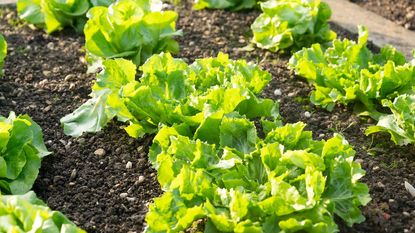Growing Gold Rush Lettuce Plants


Gold Rush lettuce is a striking loose-leaf lettuce with frilly, bright green leaves. Salad lovers appreciate Gold Rush for its unique texture and mild flavor, while gardeners value this heirloom variety because it is easy to grow and slow to bolt.
History of Gold Rush Lettuce
Not much is known about the specific history of Gold Rush lettuce, although some plant enthusiasts think it was named by California gold rush miners who ate it to stave off scurvy, a disease caused by a vitamin C deficiency. Plant historians believe that lettuce (Latuca sativa), in general, evolved from a wild plant that was cultivated as early as 550 BC. By the mid-sixteenth century, European gardeners were growing at least eight separate lettuce varieties.
Growing Gold Rush Lettuce
Growing Gold Rush lettuce is a cinch, even in a small garden, as long as you have a location where the plant gets at least six hours of sunlight per day. If you can't find seeds at your local garden center, seek out nurseries that specialize in heirloom plants.
Although Gold Rush is slower to bolt than most varieties, it is a cool weather plant that performs best in spring and autumn. It will tolerate light frost but it won't withstand intense heat.
You can plant lettuce soon after soil temperatures reach 40 degrees F. (4 C.), but the seeds germinate best when days are between 55 and 65 degrees (12 to 18 C.). Lettuce prefers rich, fertile soil, so it's a good idea to dig in a few inches of compost or manure and a general-purpose garden fertilizer before planting seeds. Plant the seeds no more than ½ inch deep, then water lightly and keep the soil moist until the seeds germinate in seven to 10 days.
Thin the Gold Rush lettuce plants to a distance of 8 to12 inches when the seedlings have three to four leaves. Just after thinning is a good time to provide a dry nitrogen fertilizer, which promotes plant growth. Sprinkle the fertilizer along the side of the plants, then water it into the soil. Lettuce performs best with 1 to 2 inches of water per week, depending on temperature and type of soil. Beware of extremes in moisture, which can result in slow development, tough leaves, and an unpleasant flavor. A soaker hose or drip system is best because it keeps the leaves dry and conserves water. A thin layer of organic mulch also helps keep the soil moist.
Pick Gold Rush lettuce any time after the formation of leaves. If you pick the older leaves first, the young, tender leaves will continue to grow. Be sure to harvest the lettuce before the stalk forms, as the leaves will be tough and bitter.
Gardening tips, videos, info and more delivered right to your inbox!
Sign up for the Gardening Know How newsletter today and receive a free download of our most popular eBook "How to Grow Delicious Tomatoes."

A Credentialed Garden Writer, Mary H. Dyer was with Gardening Know How in the very beginning, publishing articles as early as 2007.
-
 How To Grow Garden To Table: A Guide For Home Cooks
How To Grow Garden To Table: A Guide For Home CooksWhat could be better than a meal that comes directly from garden to table? Show off your gardening and culinary skills with the very freshest food.
By Bonnie L. Grant
-
 Want a Backyard Mini Orchard? Create Your Own Container Orchard
Want a Backyard Mini Orchard? Create Your Own Container OrchardEasier to care for in small spaces, a backyard mini-orchard makes sense for busy gardeners and juicy fruit is the reward.
By Teo Spengler